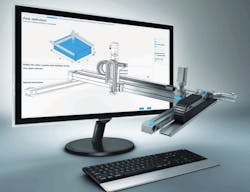Online tools that help engineers select the right components and devices for the systems or work cells they’re designing have been popular for years. But there has been little news within recent memory of significant advances made in this area.
Now, based on new announcements from Festo and Parker Hannifin, it appears that configuration tools are making a bit of a comeback in terms of bringing new levels of functionality to engineers. While these new configuration tools remain, essentially, the kind of product selector guides we’re very familiar with, their application goes a step further than typical online configuration tools.
In Parker Hannifin’s case, its Virtual Engineer motion control design tool appears to be a basic configurator in that users enter their application specifications—such as speed, load, external forces, axis orientation and motion profiles—and are then guided toward accurately sized product options. What happens next is what differentiates the Virtual Engineer from more common online configuration tools. Once the user selects the product(s) needed, the Virtual Engineer delivers a custom specification report, CAD models, and a ready-to-issue request for quote.
Other Virtual Engineer features include product life estimation, a “compare” function for multiple products, and a “My Projects” area that allows engineers to create, save and share projects for future reference. at a later date.
In other configurator news, Festo announced that it has extended the capabilities of its Online Handling Guide for designing Cartesian robots. The added dimension here is that the Online Handling Guide’s new capabilities address the robot’s controller as well as the corresponding control cabinet, components and wiring. According to Festo, control cabinets designed using the Online Handling Guide will arrive fully wired and ready to be installed. “The OEM simply adds power, Ethernet connection, I/O and wiring to the gantry motors,” says Festo in its release announcing the configurator’s new capabilities.
The release from Festo also notes that OEMs can use a function block to fill in key motion parameters on the configured control cabinet. “No specialized or manufacturer-specific programming knowledge is required,” says Festo. “Basic motion can be taught through a web server or iOS or Android app.”
Having begun operations just two years ago, Festo’s Online Handling Guide was initially equipped with basic application information such as load, cycle time, load voltage and workspace size. These parameters enabled an engineer to specify a single axis, 2D or 3D Cartesian robot and receive a CAD drawing of the robot in about 20 minutes, with quotes delivered within 48 hours. OEMs have the option of ordering a gantry fully assembled or as disassembled modules.
The control cabinet delivered via the Online Handling Guide is Festo’s Motion Control Package (FMCP)—a control system for coordinated motion of up to six axes for pick-and-place and other high-speed, precision Cartesian robotic applications. According to the company, this prewired and ready-to-install control system provides the kinematics for H-portal, T-portal, 2D and 3D Festo standard gantry systems. Festo notes that FMCP is compatible with all leading control architectures to ease integration.
The FMCP provides:
- A complete robotic solution through a single part number that includes motion controller and accessories.
- A prewired UL508A-certified cabiinet with Category 4 Safe Torque Off (STO/SS1 type C). Signals are prewired to each motor controller with all signals routed through the bottom of the cabinet via heavy duty connectors.
- Pre-configured motor controllers—each axis coming with the axis configurations, motor parameters and IP address.
- Multi-axis control, interpolated motion and fieldbus integration with standardized function blocks. The controller can act as the single connection to higher-level systems, significantly lowering the number of IP addresses in the IT infrastructure.
The FMCP can also be used to address robotic end-of-arm-tooling. Via its IO-Link connection, the FMCP can reportedly control eight external digital inputs and eight digital outputs within the standard function block.
About the Author
David Greenfield, editor in chief
Editor in Chief

Leaders relevant to this article:
